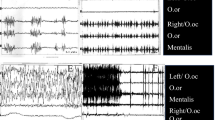Abstract
To assess spontaneous blinking and anomalous eyelid movements in patients with hemifacial spasm with an emphasis on interocular differences. Spontaneous eyelid movements were registered bilaterally for 3 min using a high-speed video camera in 28 patients with hemifacial spasm (HFS) who had not been treated with botulinum toxin injections for at least 5 months. The degree of blink conjugacy, maximum velocity, and amplitude of the closing phase of the blinks were determined for the affected and non-affected sides. Out of the 28 subjects, 23 (82%) presented with abnormal nonconjugate spasms that were similar to blinks, and in 17 (61%), high-frequency eyelid twitches were detected between blinks on the affected eye. The rate of nonconjugate blink-like spasms ranged from 0.3 to 24.7 movements/min. With regard for conjugate blinks, there was no significant interocular difference in amplitudes or eyelid closure velocities. The amplitude and velocity were significantly lower for nonconjugate movements than for spontaneous blinks. HFS is a unique condition in which complex patterns of eyelid movements, including both conjugate and nonconjugate movements, are present. Conjugate movements correspond to spontaneous blinking, and the same metrics were observed in affected and non-affected eyes. Nonconjugate movements correspond to anomalous nonconjugate blink-like spasms and high-frequency eyelid twitches in the affected eye, both of which were characterized by lower amplitudes and velocities than were observed in conjugate movements.




Similar content being viewed by others
References
Wang A, Jankovic J (1998) Hemifacial spasm: clinical findings and treatment. Muscle Nerve 21:1740–1747
Chaudhry N, Srivastava A, Joshi L (2015) Hemifacial spasm: the past, present and future. J Neurol Sci 356(1–2):27–313
Abbruzzese G, Berardelli A, Defazio G (2011) Hemifacial spasm. Hyperkinetic Mov Disord 100:675–680
Ross AH, Elston JS, Marion MH, Malhotra R (2011) Review and update of involuntary facial movement disorders presenting in the ophthalmological setting. Surv Ophthalmol 56:54–67
Stava MW, Huffman MD, Baker RS, Epstein AD, Porter JD (1994) Conjugacy of spontaneous blinks in man: eyelid kinematics exhibit bilateral symmetry. Invest Ophthalmol Vis Sci 35:3966–3971
Huffman MD, Baker RS, Stava MW, Chuke JC, Rouholiman BR, Porter JD (1996) Kinematic analysis of eyelid movements in patients recovering from unilateral facial nerve palsy. Neurology 46:1079–1085
Cruz AA, Garcia DM, Pinto CT, Cechetti SP (2011) Spontaneous eyeblink activity. Ocul Surf 9(1):29–41
Evinger C, Ka M, Pa S (1991) Eyelid movements. Mechanisms and normal data. Invest Ophthalmol Vis Sci 32:387–400
Palakuru J, Wang J, Aquavella JV (2007) Effects of blinking on tear dynamics. Invest Ophthalmol Vis Sci 48:3032–3037
Garcia D, Barbosa JC, Pinto CT, Cruz AA (2013) Estimation of spontaneous blinking main sequence in normal subjects and patients with graves’ upper eyelid retraction. Invest Ophthalmol Vis Sci 54:1434–1442
Wambier SP, Garcia DM, Cruz AA, Messias A (2016) Spontaneous blinking kinetics on paralytic Lagophthalmos after lid load with gold weight or autogenous temporalis fascia sling. Curr Eye Res 41(4):433–440
Baccega A, Garcia DM, Cruz AAV (2017) Spontaneous blinking kinematics in patients who have undergone Autogeneous fascia Frontalis suspension. Curr Eye Res 42(9):1248–1253
Kimura N, Watanabe A, Suzuki K, Toyoda H, Hakamata N, Fukuoka H, Washimi Y, Arahata Y, Takeda A, Kondo M, Mizuno T, Kinoshita S (2017) Measurement of spontaneous blinks in patients with Parkinson's disease using a new high-speed blink analysis system. J Neurol Sci 380:200–204
Jankovic J, Kenney C, Grafe S, Goertelmeyer R, Comes G (2009) Relationship between various clinical outcome assessments in patients with blepharospasm. Mov Disord 24:407–413
Wambier S, Ribeiro SF, Garcia DM et al (2014) Two-dimensional video analysis of the upper eyelid motion during spontaneous blinking. Ophthal Plast Reconstr Surg 30:146–151
Manning KA, Evinger C, Sibony PA (1990) Eyelid movements before and after Botulinum therapy in patients with lid spasm. Ann Neurol 28:653–660
Porter JD, Burns LA, May PJ (1989) Morphological substrate for eyelid movements: innervation and structure of primate levator palpebrae superioris and orbicularis oculi muscles. J Comp Neurol 287:64–81
Osaki MH, Osaki TH, Osaki T, Gameiro GR, Belfort R Jr, Marie SKN (2019) Orbicularis oculi morphological alterations in affected and non-affected sides in hemifacial spasm. J Neuro-ophthalmol. https://doi.org/10.1097/WNO.0000000000000823
Hasan SA, Baker RS, Sun WS, Rouholiman BR, Chuke JC, Cowen DE, Porter JD (1997) The role of blink adaptation in the pathophysiology of benign essential blepharospasm. Arch Ophthalmol 115(5):631–6.27
Aramideh M, Ongerboer de Vissser BW, Devriese PP et al (1994) Electromyographic features of levator palpebrae superioris and orbicularis oculi muscles in blepharospasm. Brain 117:27–38
Bentivoglio AR, Daniele A, Albanese A, Tonali PA, Fasano A (2006) Analysis of blink rate in patients with blepharospasm. Mov Disord 21(8):1225–1229
Ferrazzano G, Conte A, Belvisi D, Fabbrini A, Baione V, Berardelli A, Fabbrini G (2019) Writing, reading, and speaking in blepharospasm. J Neurol 266(5):1136–1140
Lee WH, Seo JM, Hwang JM (2017) The analysis of eye blinking pattern using high-frame-rate camera. Conf Proc IEEE Eng Med Biol Soc 2017:1509–1512
Doane MG (1980) Interactions of eyelids and tears in corneal wetting and the dynamics of the normal human eyeblink. Am J Ophthalmol 89:507–516
Kwon K-A, Shipley RJ, Edirisinghe M, Ezra DG, Rose G, Best SM, Cameron RE (2013) High-speed camera characterization of voluntary eye blinking kinematics. J R Soc Interface 10(85):213–227
Malbouisson J, Messias A, Garcia DM et al (2010) Modeling upper eyelid kinematics during spontaneous and reflex blinks. J Neurosci Methods 191:119–125
Sforza C, Rango M, Galante D et al (2008) Spontaneous blinking in healthy persons: an optoelectronic study of eyelid motion. Ophthalmic Physiol Opt 28:345–353
Frigerio A, Hadlock TA, Murray EH, Heaton JT (2014) Infrared-based blink-detecting glasses for facial pacing: toward a bionic blink. JAMA Facial Plast Surg 16:211–218
Hanuka A, Itzhak M, Berger A et al (2017) A novel eyelid motion monitor. Graefes Arch Clin Exp Ophthalmol 255:1811–1817
Hershman R, Henik A, Cohen N (2018) A novel blink detection method based on pupillometry noise. Behav Res Methods 50:107–114
Author information
Authors and Affiliations
Contributions
Midori H. Osaki: (1) research project: (a) conception, (b) organization, (c) execution; (2) statistical analysis: (a) design, (b) review, (c) and critique; (3) manuscript preparation: (a) writing of the first draft and (b) review and approval of the final version.
Tammy H. Osaki: (1) research project: (a) conception, (b) organization, (c) execution; (2) statistical analysis: (a) review and critique; (3) manuscript preparation: (a) review and critique and (b) approval of the final version.
Denny Garcia: (1) research project: (a) execution; (2) statistical analysis: (a) design and (b) execution; (3) manuscript preparation: (a) review and critique and (b)approval of the final version.
Teissy Osaki: (1) research project: (a) organization and (b) execution; (2) statistical analysis: (a) review and critique; (3) manuscript preparation: (a) review and critique and (b) approval of the final version.
Gustavo Gameiro: (1) research project: (a) execution; (2) statistical analysis: (a) review and critique; (3) manuscript preparation: (a) review and critique and (b) approval of the final version.
Rubens Belfort Jr.: (1) research project: (a) conception; (2) statistical analysis: (a) review and critique; (3) manuscript preparation: (a) review and critique and (b) approval of the final version.
Antonio Augusto Cruz: (1) research project: (a) conception, (b) organization; (2) statistical analysis: (a) review and critique; (3) manuscript preparation: (a) review and critique and (b) approval of the final version.
Corresponding author
Ethics declarations
Conflict of interest
The authors declare that they have no conflict of interest.
Ethical approval
All procedures performed in studies involving human participants were in accordance with the ethical standards of the UNIFESP IRB (number 1322/2016) and with the 1964 Helsinki declaration and its later amendments or comparable ethical standards.
Informed consent
was obtained from all individual participants included in the study.
Additional information
Publisher’s note
Springer Nature remains neutral with regard to jurisdictional claims in published maps and institutional affiliations.
Rights and permissions
About this article
Cite this article
Osaki, M.H., Osaki, T.H., Garcia, D. et al. Analysis of blink activity and anomalous eyelid movements in patients with hemifacial spasm. Graefes Arch Clin Exp Ophthalmol 258, 669–674 (2020). https://doi.org/10.1007/s00417-019-04567-w
Received:
Revised:
Accepted:
Published:
Issue Date:
DOI: https://doi.org/10.1007/s00417-019-04567-w




